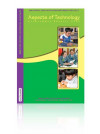In 2008, the second year of the fourth cycle of national monitoring, three areas were assessed: music, aspects of technology, and reading and speaking. This report presents details and results of the assessments of aspects of technology. Technology is a creative, purpose-ful activity aimed at meeting needs and opportunities through the development of products, systems or environments. Knowledge, skills and resources are combined to help solve practical problems in particular social contexts.
A framework for technology education and its assessment is presented in Chapter 2. The framework highlights the three strands of the New Zealand technology curriculum:
- technological knowledge and understanding;
- technological capability;
- understanding and awareness of the relationship between technology and society.
Technology is a multidisciplinary activity. To attempt to represent all or even most of the areas, meanings and applications of technology within the national monitoring assessment programme would be unrealistic. After careful examination of the scope of the technology curriculum, it was decided to assess some key aspects, with a particular focus on the knowledge, understandings and skills listed above. Selected areas of content and broadly overlapping contexts (e.g. personal, home, school, community) have been used to investigate the ideas students have and the processes they can use.
New Zealand’s National Education Monitoring Project commenced in 1993, with the task of assessing and reporting on the achievement of New Zealand primary school children in all areas of the school curriculum. Children are assessed at two class levels: year 4 (halfway through primary education) and year 8 (at the end of primary education). Different curriculum areas and skills are assessed each year, over a four-year cycle. The main goal of national monitoring is to provide detailed information about what children know, think and can do, so that patterns of performance can be recognised, successes celebrated, and desirable changes to educational practices and resources identified and implemented.
Each year, random samples of children are selected nationally, then assessed in their own schools by teachers specially seconded and trained for this work. Task instructions are given orally by teachers, through video presentations, on laptop computers, or in writing. Many of the assessment tasks involve the children in the use of equipment and materials. Their responses are presented orally, by demonstration, in writing, in computer files, or through other physical products. Many of the responses are recorded on videotape for subsequent analysis.
Key Results
The 2008 Technology results show that technology is a highly popular subject area, particularly among year 8 students. Students enjoy making things in school and, at year 8, learning how to use tools. There is moderate growth from year 4 to year 8 in most technology tasks, with stronger gains seen in areas that require generating a design, or looking at broader societal and family concerns of the impact of technology. Gender differences tend to “average out” with students typically doing better with tasks traditionally linked to their gender. Pakeha/Māori differences and Pakeha/Pasifika differences remained in the moderate to large range, with no discernible trends seen over time. Socio-economic status remained a strong predictor of performance at the school level, with the other school variables showing only a minor influence on results.

